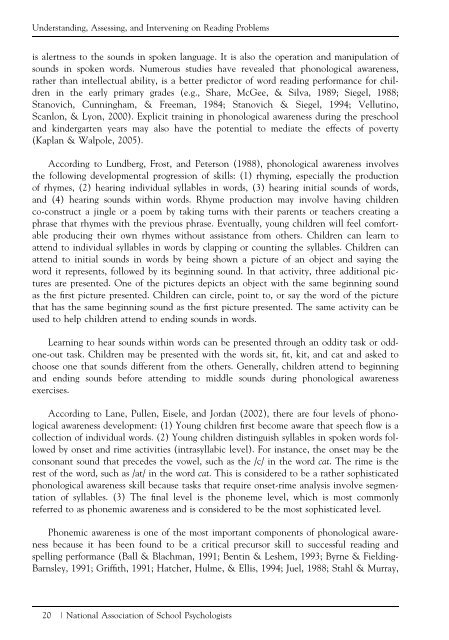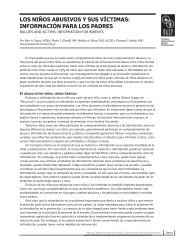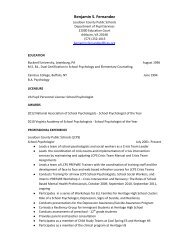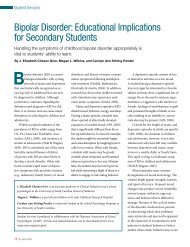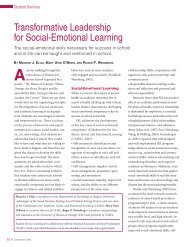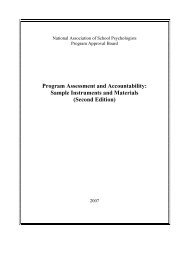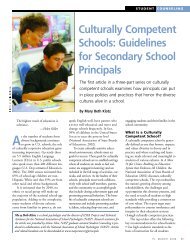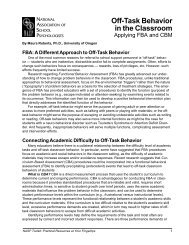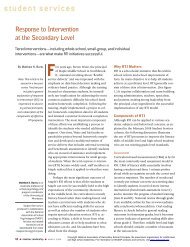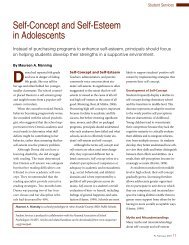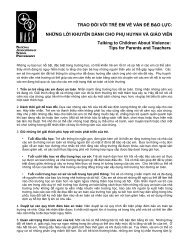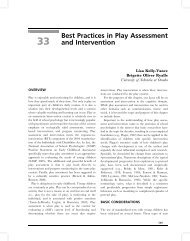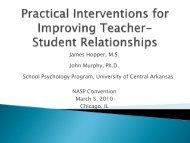Chapter 1 - National Association of School Psychologists
Chapter 1 - National Association of School Psychologists
Chapter 1 - National Association of School Psychologists
Create successful ePaper yourself
Turn your PDF publications into a flip-book with our unique Google optimized e-Paper software.
Understanding, Assessing, and Intervening on Reading Problems<br />
is alertness to the sounds in spoken language. It is also the operation and manipulation <strong>of</strong><br />
sounds in spoken words. Numerous studies have revealed that phonological awareness,<br />
rather than intellectual ability, is a better predictor <strong>of</strong> word reading performance for children<br />
in the early primary grades (e.g., Share, McGee, & Silva, 1989; Siegel, 1988;<br />
Stanovich, Cunningham, & Freeman, 1984; Stanovich & Siegel, 1994; Vellutino,<br />
Scanlon, & Lyon, 2000). Explicit training in phonological awareness during the preschool<br />
and kindergarten years may also have the potential to mediate the effects <strong>of</strong> poverty<br />
(Kaplan & Walpole, 2005).<br />
According to Lundberg, Frost, and Peterson (1988), phonological awareness involves<br />
the following developmental progression <strong>of</strong> skills: (1) rhyming, especially the production<br />
<strong>of</strong> rhymes, (2) hearing individual syllables in words, (3) hearing initial sounds <strong>of</strong> words,<br />
and (4) hearing sounds within words. Rhyme production may involve having children<br />
co-construct a jingle or a poem by taking turns with their parents or teachers creating a<br />
phrase that rhymes with the previous phrase. Eventually, young children will feel comfortable<br />
producing their own rhymes without assistance from others. Children can learn to<br />
attend to individual syllables in words by clapping or counting the syllables. Children can<br />
attend to initial sounds in words by being shown a picture <strong>of</strong> an object and saying the<br />
word it represents, followed by its beginning sound. In that activity, three additional pictures<br />
are presented. One <strong>of</strong> the pictures depicts an object with the same beginning sound<br />
as the first picture presented. Children can circle, point to, or say the word <strong>of</strong> the picture<br />
that has the same beginning sound as the first picture presented. The same activity can be<br />
used to help children attend to ending sounds in words.<br />
Learning to hear sounds within words can be presented through an oddity task or oddone-out<br />
task. Children may be presented with the words sit, fit, kit, and cat and asked to<br />
choose one that sounds different from the others. Generally, children attend to beginning<br />
and ending sounds before attending to middle sounds during phonological awareness<br />
exercises.<br />
According to Lane, Pullen, Eisele, and Jordan (2002), there are four levels <strong>of</strong> phonological<br />
awareness development: (1) Young children first become aware that speech flow is a<br />
collection <strong>of</strong> individual words. (2) Young children distinguish syllables in spoken words followed<br />
by onset and rime activities (intrasyllabic level). For instance, the onset may be the<br />
consonant sound that precedes the vowel, such as the /c/ in the word cat. The rime is the<br />
rest <strong>of</strong> the word, such as /at/ in the word cat. This is considered to be a rather sophisticated<br />
phonological awareness skill because tasks that require onset-rime analysis involve segmentation<br />
<strong>of</strong> syllables. (3) The final level is the phoneme level, which is most commonly<br />
referred to as phonemic awareness and is considered to be the most sophisticated level.<br />
Phonemic awareness is one <strong>of</strong> the most important components <strong>of</strong> phonological awareness<br />
because it has been found to be a critical precursor skill to successful reading and<br />
spelling performance (Ball & Blachman, 1991; Bentin & Leshem, 1993; Byrne & Fielding-<br />
Barnsley, 1991; Griffith, 1991; Hatcher, Hulme, & Ellis, 1994; Juel, 1988; Stahl & Murray,<br />
20 <strong>National</strong> <strong>Association</strong> <strong>of</strong> <strong>School</strong> <strong>Psychologists</strong>


